 Free delivery on orders over £75 ex VAT
Free delivery on orders over £75 ex VAT Free click & collect from branches nationwide
Free click & collect from branches nationwideThe primary building regulations for ventilation in England are set out in Approved Document F (ADF) of the Building Regulations. While the concept of ventilating buildings has been part of building regulations for many years (ADF was initially published in 2010), the most significant and recent updates were introduced in June 2022.
These changes were made to address the challenges posed by increasingly airtight, energy-efficient homes. The goal is to ensure adequate ventilation to protect the health of occupants from a build-up of moisture, pollutants, and stale air, while also supporting the UK government's wider goal of a Future Homes and Buildings Standard by 2025.
Here at City Plumbing, we discuss ventilation regulations to help keep both homeowners and installers updated and safe.
What is Part F?
In England, "Part F" refers to Part F of the Building Regulations, which deals specifically with ventilation. The official guidance on how to comply with these regulations is contained within Approved Document F (ADF).
The core purpose of Part F is to ensure that all buildings, both residential and non-residential, have an "adequate means of ventilation provided for people in the building." This is to protect the health of occupants and the integrity of the building itself from the negative effects of poor air quality.
Ultimately, Part F has been introduced to ensure homes become more energy-efficient and remain healthy, safe, and free from the problems associated with poor indoor air quality.
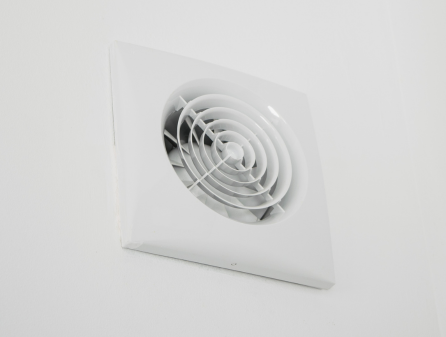
What are The Key Changes & Requirements of Part F Regulations?
1. Types of Ventilation
ADF outlines three main types of ventilation that a dwelling must have:
- Whole-dwelling ventilation: Provides a continuous background supply of fresh air to the entire home. This is essential for maintaining general air quality and preventing the build-up of pollutants over time.
- Extract ventilation: Aims to remove moisture and pollutants from specific rooms where they are generated, such as kitchens, bathrooms, utility rooms, and toilets. This is typically achieved with extractor fans.
- Purge ventilation: Allows for the rapid dilution and removal of high levels of pollutants or moisture, for example, after cooking or cleaning. This is usually accomplished by opening a window.
2. Requirements for Dwellings
- Trickle Vents: The updated regulations emphasise the use of trickle vents in windows and doors. When replacing windows, if the existing ones had trickle vents, the new ones must also have them. Even if the old windows did not have them, the new ones will likely be required to, as a home's ventilation must not be made "less satisfactory" as a result of building work. Minimum sizes for trickle vents are specified in ADF, and they vary depending on the type of room (e.g. habitable room vs. bathroom) and the type of building (multi-storey vs. single-storey).
- Extract Fan Rates: Specific minimum extract rates are set for wet rooms:
- Kitchens: 30 litres per second (l/s) for a cooker hood, or 60 l/s for other extract fans.
- Bathrooms: 15 l/s.
- Utility rooms: 30 l/s.
- Toilets (WC): 6 l/s.
- Purge Ventilation: Rooms must have a window or door that can be opened to provide purge ventilation. The size of the opening required is a proportion of the room's floor area (e.g. an opening equal to at least 1/20th of the floor area if the opening angle is greater than 30 degrees).
- Airtightness: As buildings are designed to be more airtight for energy efficiency (Part L of the Building Regulations), the importance of mechanical ventilation systems like Continuous Mechanical Extract Ventilation (MEV) or Mechanical Ventilation with Heat Recovery (MVHR) increases. These systems are often necessary in highly insulated new builds to ensure adequate airflow.
- Roof Ventilation: For loft conversions or when adding a habitable room to a previously open roof space, proper ventilation must be provided to prevent condensation. This involves creating a continuous airflow path between the insulation and the roof covering, often through continuous openings at the eaves and ridge.
3. Compliance and Documentation
- Building Control: Any building work that impacts ventilation, such as new builds, extensions, or major renovations, must comply with Part F and be checked by a building control body (either a local authority or an approved inspector).
- Commissioning and Testing: Mechanical ventilation systems must be inspected, tested, and commissioned by a qualified professional to ensure they meet the required flow rates. A commissioning document must be completed and left with the homeowner.
- Providing Information: The person carrying out the work must provide the homeowner with information on how the ventilation system is controlled and maintained.
Is It a Legal Requirement to Have an Extractor Fan in the Kitchen UK?
As per UK building regulations, particularly Approved Document F (ADF), a ducted extractor fan in the kitchen is essential for health and building preservation.
Ducted extractor fans create healthy, durable, and safe homes. Going beyond just removing cooking smells, they’re a fundamental part of a proper ventilation strategy designed to protect both the occupants' health and the integrity of the building itself.
The Core Problem: Moisture and Pollutants
Cooking, especially on a hob, generates a significant amount of airborne moisture, grease, and other pollutants. Without an effective ventilation system, these substances can cause:
- Condensation: Warm, moist air from cooking rises and meets cooler surfaces, such as walls and windows. This leads to condensation, which is the perfect breeding ground for mould and mildew.
- Mould Growth: Mould is not just unsightly, it can pose a serious risk to health, causing or exacerbating respiratory problems, allergies, and asthma.
- Damage to Property: Over time, continuous moisture can damage the building fabric, leading to peeling paint, warped cabinetry, and even structural issues.
- Poor Air Quality: The fumes, odours, and volatile organic compounds (VOCs) released during cooking can be harmful when inhaled in high concentrations. A ducted fan removes these pollutants, contributing to a healthier indoor environment.
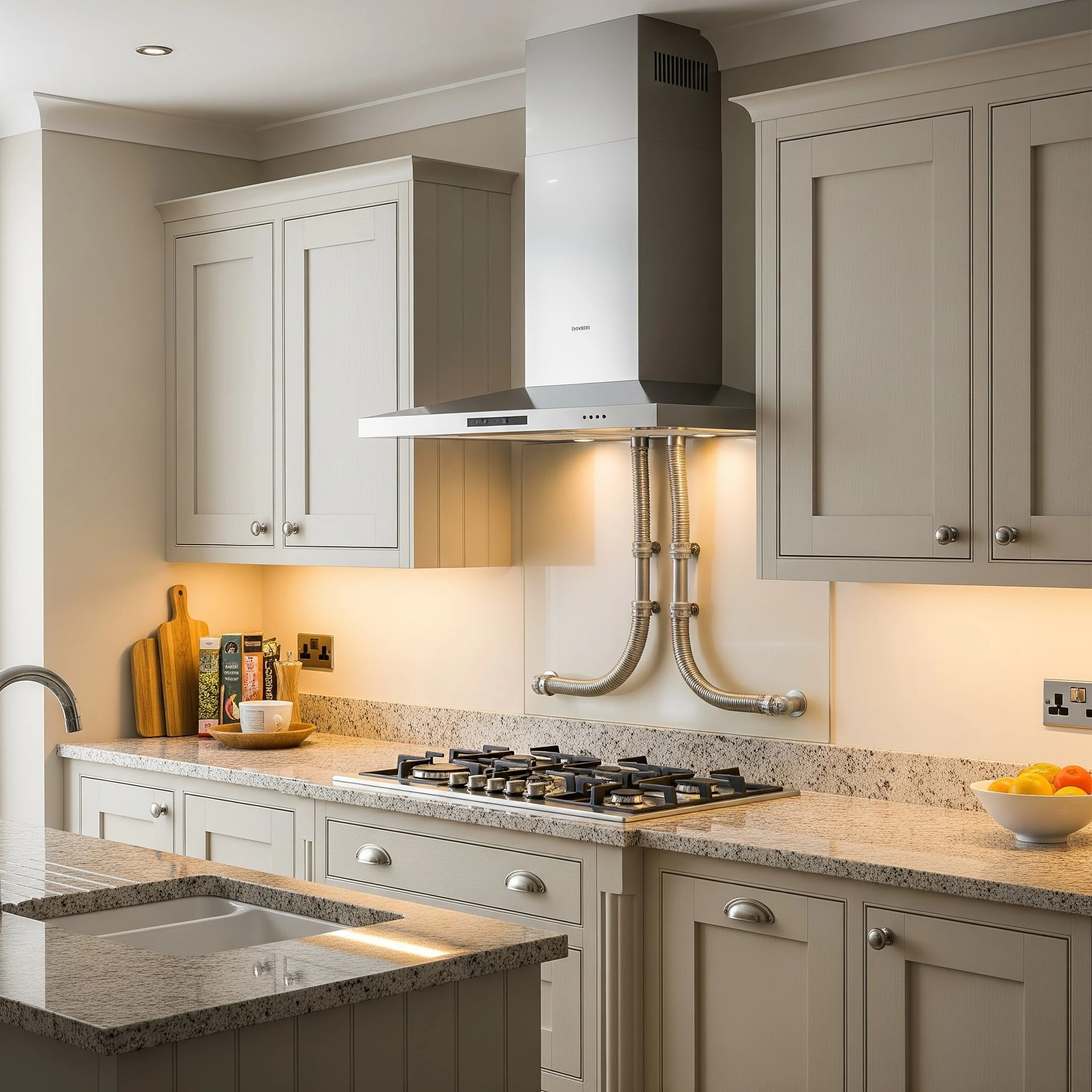
The Solution: Ducted Extraction
A ducted extractor fan, which vents air to the outside of the building, is the only system that fully addresses the issues of moisture and pollutants. This is in contrast to a recirculating hood, which only filters grease and odours and then releases the moisture back into the kitchen.
Under the UK Building Regulations (ADF), a ducted extractor fan is a legal requirement in specific circumstances:
- New Dwellings and Extensions: All new-build homes and extensions that include a kitchen must have a mechanical extract ventilation system that vents to the outside.
- Major Refurbishments: If a major refurbishment involves changes to the kitchen that affect the ventilation, a ducted system is required.
- Replacement of Existing Ducted Fans: If an existing ducted fan is being replaced, the new one must be of equal or better performance.
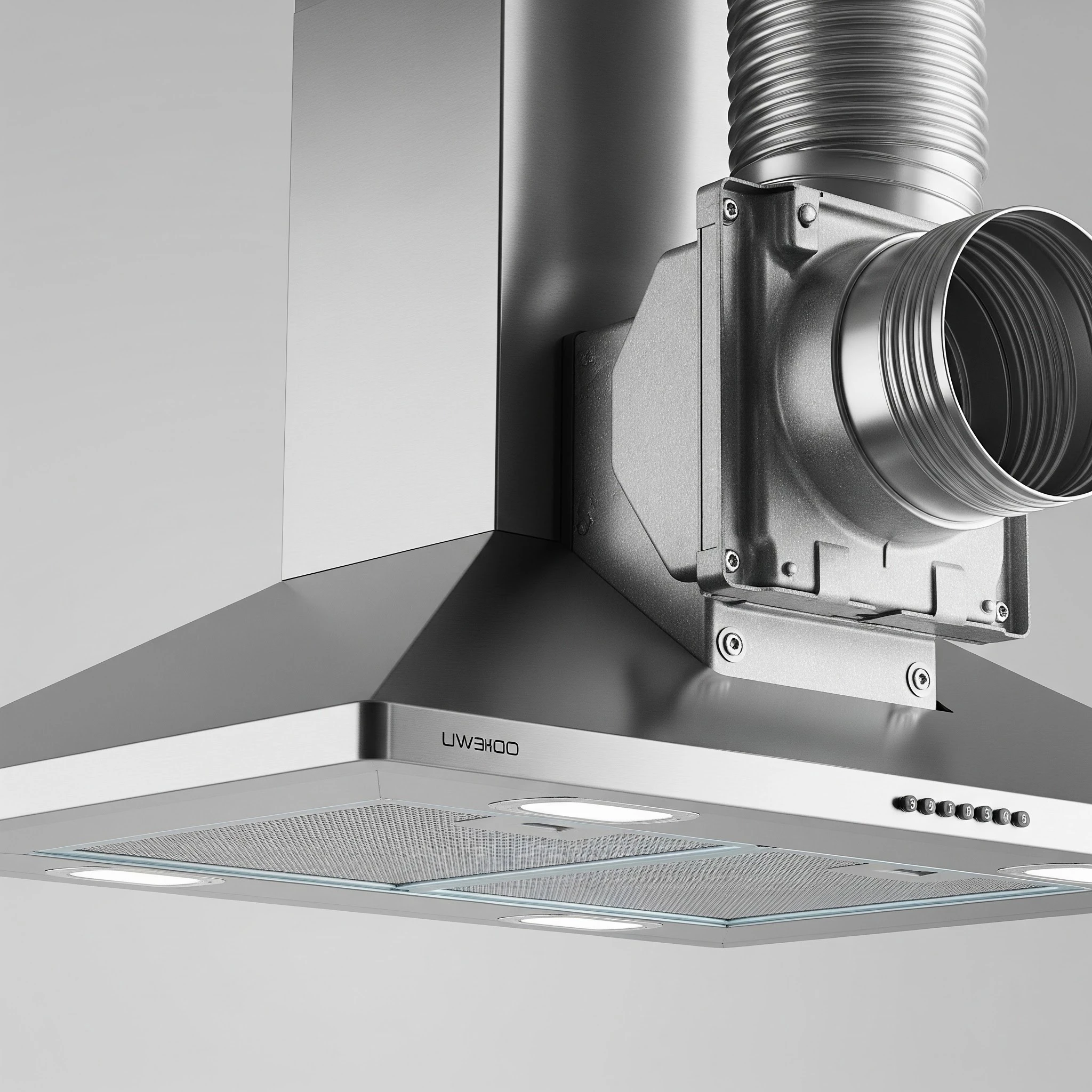
Key Regulatory Requirements
ADF sets out specific performance standards for these systems to ensure they are effective:
- Minimum Extraction Rates:
- 30 litres per second (l/s): If the fan is a cooker hood located directly above the hob.
- 60 litres per second (l/s): If the fan is located elsewhere in the kitchen (e.g. a wall or ceiling fan).
- Ducting Efficiency: While the regulations don't specify the type of ducting, they do require that the system as a whole achieves the minimum airflow rates. This means the ducting must be properly installed with minimal bends and an appropriate diameter to prevent a significant loss of air pressure.
- Commissioning: The 2022 updates to ADF made it a legal requirement for the installer to test and commission the installed fan to prove that it is meeting the required airflow rates. This documentation must be provided to both the homeowner and the Building Control body.
What This Means for Homeowners and Installers
- For Homeowners: It's crucial to understand that a recirculating hood, while visually appealing and effective for smells, does not meet the legal requirements for a new kitchen. If you are building or extending, you will need to install a separate ducted extract fan to comply with the law and protect your property from moisture damage.
- For Installers: Installers have a legal responsibility to ensure their work is compliant. They must be able to advise customers on the difference between ducted and recirculating systems and, for new builds, ensure a ducted system is installed and properly commissioned. Failure to do so can result in legal action and the requirement to redo the work.
Can Recirculating Hoods Be Used As Kitchen Ventilation?
While a recirculating hood is a useful appliance for removing grease and odours, it does not fulfil the legal requirement for extract ventilation in a new kitchen. This is because it fails to remove moisture, which is a primary concern of the Building Regulations.
Installers must guide their customers to a compliant solution, which will always involve a ducted extract fan.
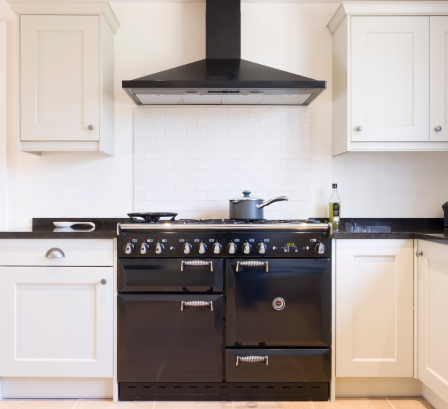
Here's a breakdown of how recirculating hoods are treated, and what the regulations mean for installers and homeowners.
1. Recirculating Hoods and Building Regulations
Under Approved Document F (ADF), which governs ventilation in England, a recirculating cooker hood does not count towards the required kitchen extract ventilation.
- Difference between Appliances:
- Extractor Hood (Ducted): A traditional extractor hood pulls air, moisture, and grease from the kitchen and expels it to the outside via ducting and an external vent. This system is effective at removing pollutants and moisture from the home, and it fully meets the requirements of ADF. The minimum extract rate for this type of system is 30 litres per second (l/s).
- Recirculating Hood (Filter-based): This type of hood, also known as a filter hood, pulls air from the kitchen, passes it through a grease filter and then a carbon filter, and then re-releases the "cleaned" air back into the room.
- Key limitation: While it removes grease and odours, it does not remove moisture. This is a critical point, as the buildup of moisture from cooking can lead to condensation and mould. For this reason, it is not considered an "extract ventilation" system under the regulations.
2. Recirculating Hoods in New Builds vs. Existing Homes
- New Builds (and Major Renovations): In a new build, extension, or major refurbishment that adds a kitchen, you are legally required to install a mechanical extract fan that vents to the outside.
- You can still install a recirculating cooker hood, but it must be in addition to a separate extract fan that meets the ADF requirement of 60 l/s (as it's not a cooker hood). This separate fan would typically be a wall or ceiling fan located elsewhere in the kitchen.
- Existing Homes (Minor Work): If you are simply replacing a kitchen in an existing home without making changes to the structure, you are not legally required to upgrade the ventilation system, unless the existing ventilation is made "less satisfactory" as a result of the work. However, Building Control would still recommend installing a ducted extract system to prevent moisture buildup.
3. Measurements and Compliance
- ADF only specifies measurements for Ducted Fans: The minimum extract rates (30 l/s for cooker hoods, 60 l/s for other fans) apply to ducted systems. Recirculating hoods have no specified minimum performance requirements under ADF because they do not fulfil the function of extract ventilation.
- Installation - A Professional Should Do This:
- Electrical Safety: Installation of any fan, whether recirculating or ducted, falls under Part P of the Building Regulations for electrical safety. A qualified electrician should always carry out the work to ensure it is safe and compliant.
- Building Control: For new builds or major renovations, the installer must ensure the whole-house ventilation strategy, including the kitchen extract, meets the requirements of ADF. This will be checked by a Building Control inspector.
- Commissioning: For a ducted system, the installer must be able to prove that the fan, once installed with its ducting, meets the required airflow rates. This is done through a commissioning test, and the results must be documented and given to the homeowner and Building Control. A recirculating hood does not require this commissioning.
4. What This Means for Installers
- Knowledge is Key: Installers must be fully aware of the distinction between ducted and recirculating hoods and how they relate to Building Regulations. They should not advise a customer that a recirculating hood is a compliant replacement for a ducted one in a new build.
- Advising the Customer: When discussing kitchen plans, especially for new builds or extensions, installers must explain to customers that if they choose a recirculating hood for aesthetic reasons, they will still need to install a separate, ducted extract fan to meet legal requirements.
- Responsibility for Compliance: The installer is responsible for ensuring that the work they carry out is compliant with all relevant regulations. Failure to do so could result in an enforcement notice from Building Control, requiring the work to be redone.
- Documentation: For ducted systems, installers must provide the required commissioning and testing documentation to demonstrate compliance. This provides a clear record for both the homeowner and the Building Control inspector.
Choose City Plumbing For Your Extractor and Ducting Requirements
From Extractor Fans & Fan Kits to Vents & Grilles to Flexible Ducting & Ducting Kits City Plumbing can help installers and homeowners stay in line with current regulations. With thousands of extractor and ducting products available online on our website and at your local CPS branch, we can help keep homes and buildings compliant, ensuring the ongoing safety of all occupants.
Other articles
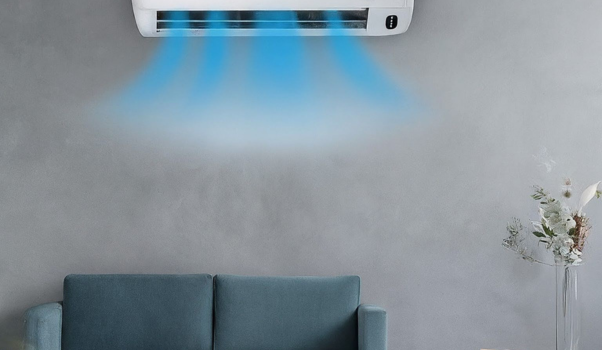
Help Customers Choose Home AC Units
17 Jul 2024 ・ 5 mins

How New Boilers Can Upgrade EPCs
24 Apr 2024 ・ 5 mins

Find Replacement Parts Easily Using Spares Finder
09 Apr 2024 ・ 5 mins
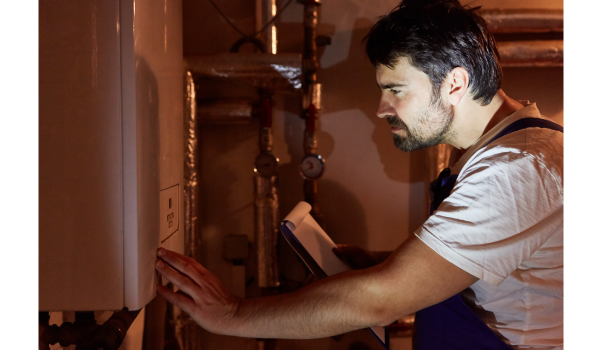
Help Homeowners Maximise Their Heating Controls
29 Feb 2024 ・ 7 mins

